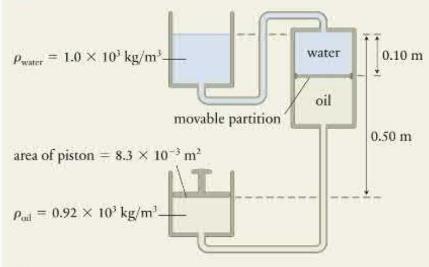In Figure 18.47, the top tank, which is open to the atmosphere, contains water (left(ho_{text {water }}=1.0
Question:
In Figure 18.47, the top tank, which is open to the atmosphere, contains water \(\left(ho_{\text {water }}=1.0 \times 10^{3} \mathrm{~kg} / \mathrm{m}^{3}\right)\) and the bottom tank contains oil \(\left(ho_{\text {oil }}=0.92 \times 10^{3} \mathrm{~kg} / \mathrm{m}^{3}\right)\) covered by a piston. The tank on the right has a freely movable partition that keeps the oil and water separate. The partition is a vertical distance \(0.10 \mathrm{~m}\) below the open surface of the water. If the piston in the bottom tank is \(0.50 \mathrm{~m}\) below the open surface of the water and has a surface area of \(8.3 \times 10^{-3} \mathrm{~m}^{2}\), what must the mass of the piston be to keep the system in mechanical equilibrium? For simplicity, ignore the mass of the partition.
Data from Figure 18.47

Step by Step Answer:






